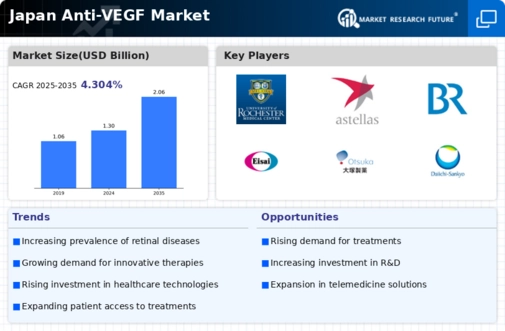Increasing Aging Population
The Anti-VEGF Market in Japan is experiencing growth due to the increasing aging population. As individuals age, they become more susceptible to retinal diseases such as age-related macular degeneration (AMD) and diabetic retinopathy. According to recent statistics, approximately 30% of the Japanese population is aged 65 and older, which correlates with a higher prevalence of these conditions. This demographic shift is likely to drive demand for anti-VEGF therapies, as healthcare providers seek effective treatments to manage these diseases. The anti vegf market is thus positioned to expand significantly, as pharmaceutical companies develop innovative solutions tailored to this aging demographic. Furthermore, the government’s focus on improving healthcare access for the elderly may further bolster the market, creating opportunities for growth in the anti vegf market.
Rising Healthcare Expenditure
Japan's increasing healthcare expenditure is a significant driver for the Anti-VEGF Market. The government has been investing heavily in healthcare infrastructure and services, with total healthcare spending reaching approximately $400 billion in recent years. This investment is aimed at improving access to advanced medical treatments, including anti-VEGF therapies. As healthcare budgets expand, there is a growing emphasis on providing effective treatments for retinal diseases, which are prevalent among the aging population. The anti vegf market stands to gain from this trend, as healthcare providers are more likely to adopt innovative therapies that demonstrate clinical efficacy. Additionally, the rising out-of-pocket expenses for patients may lead to increased demand for effective and affordable anti-VEGF options, further propelling market growth.
Growing Awareness and Education
There is a notable increase in awareness and education regarding retinal diseases and their treatments in Japan, which is positively impacting the Anti-VEGF Market. Campaigns aimed at educating both healthcare professionals and patients about the importance of early detection and treatment of conditions like AMD and diabetic retinopathy are gaining traction. This heightened awareness is likely to lead to earlier diagnoses and increased treatment rates, thereby driving demand for anti-VEGF therapies. The anti vegf market is expected to benefit from this trend, as more patients seek out effective treatments upon recognizing the symptoms of retinal diseases. Furthermore, collaborations between healthcare organizations and patient advocacy groups are fostering a more informed public, which may contribute to the overall growth of the anti vegf market.
Supportive Reimbursement Policies
Supportive reimbursement policies in Japan are facilitating access to anti-VEGF therapies, thereby driving growth in the Anti-VEGF Market. The Japanese government has implemented various reimbursement schemes that cover the costs of innovative treatments for retinal diseases. This financial support encourages healthcare providers to prescribe anti-VEGF therapies, as patients are more likely to seek treatment when costs are manageable. The anti vegf market is likely to see increased adoption of these therapies as a result of favorable reimbursement conditions. Additionally, ongoing discussions regarding the expansion of coverage for new and emerging treatments may further enhance market dynamics. As reimbursement policies evolve, they could play a pivotal role in shaping the future landscape of the anti vegf market.
Technological Innovations in Treatment
Technological advancements in the field of ophthalmology are playing a crucial role in the Anti-VEGF Market in Japan. Innovations such as sustained-release drug delivery systems and novel formulations are enhancing the efficacy and convenience of anti-VEGF therapies. For instance, recent developments have led to the creation of injectable treatments that require less frequent administration, which is particularly beneficial for patients with chronic conditions. The anti vegf market is likely to benefit from these innovations, as they improve patient adherence and outcomes. Moreover, the integration of telemedicine and digital health solutions is facilitating better monitoring and management of retinal diseases, potentially increasing the demand for anti-VEGF treatments. As these technologies continue to evolve, they may reshape the landscape of the anti vegf market, driving further growth and investment.























Leave a Comment